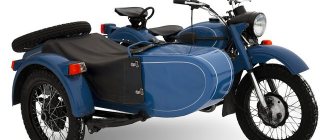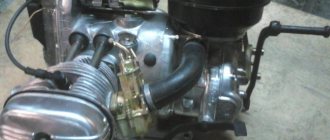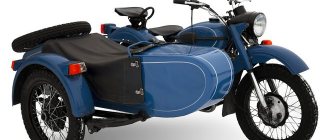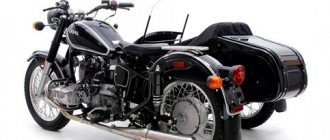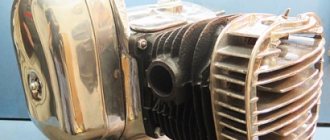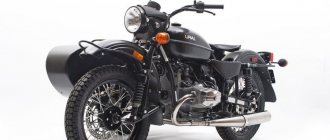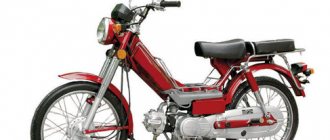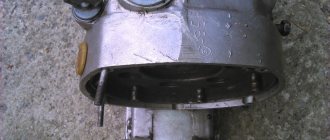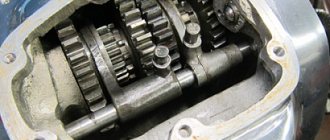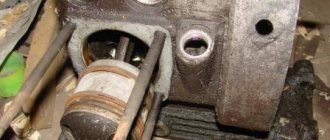Cooling with “little blood”
Install an enlarged oil pan.
This is probably the cheapest. I had aluminum cylinders and an aluminum oil pan from a salt plant. My engine did not overheat
So. not aluminum ones. alloy-s. Here!
An enlarged oil pan is for sale, the pan itself has a capacity of 2 liters + in the engine. There is no overheating at all (well, it really depends on how you drive)
Will seek. I doubt that I will find this thing in St. Petersburg. Apparently, you will have to rivet it yourself from an aluminum sheet.
I don’t know for sure whether this is true or not, but I heard that they install a pan from the Dnieper and it seems like it will add more oil. And there is no need to redo anything.
Is the pallet from the Dnieper suitable for the Urals and does it have more volume? It might be better or better to use a gasket 8 mm thick.
I don’t know for sure whether this is true or not, but I heard that they install a pan from the Dnieper and it seems like it will add more oil. And there is no need to redo anything.
Is the pallet from the Dnieper suitable for the Urals and does it have more volume? It might be better or better to use a gasket 8 mm thick.
Is the pan from the Dnieper larger when compared with the Ural one (that is, in terms of the amount of oil in it and by how much, approximately) Is it suitable for the Urals.
1st, indeed, on the last Dnieper there are lumen cylinders with a sleeve, but in the Urals they are similar to cast iron current for 720 and 750 lumen, I bought them for the Economic Council of the 649th lumen
4th, if you use the original pump, then why the hell disassemble it and clean it, or you can order larger gears from Uncle Vasya the turner and properly shovel it
and the last fifth is to pour the right oil not out of the blue. By the way, it’s not a fact that other mineral oil is worse than synthetics and semi-synthetics
For our engines, the calculation is based on the film formed by ordinary M8 or Mgd14 gas, which means that synthetics, which create a lubricating layer that is an order of magnitude smaller, may not be suitable and the engine will die prematurely, I’ve seen this
I saw a competently weakened porridge that went crazy at 140 km per hour and this was with the 8th bridge Gee gee gee
And if you increase the V of the engine and the oil, the oil seal will not burst?
I read in a motorcycle that to improve cooling it is necessary to drill holes in the cooling fins and what can this help?
In theory, the cooling surface area will increase. but if you overdo it, the ribs will play and fall off
I think with turntables on the heads it’s fine, but a radiator on a tray wouldn’t hurt either.
Will two small motors inflate enough air to cool such a mass of metal? On motors with forced For this purpose, cooling is provided by a healthy turbine driven by the crankshaft, which consumes up to 10% of the engine’s power. Install a turbine from Zaporozhets and air ducts to the cylinders? But this is a lot of blood.
To all this we add the injection of cooled oil not back into the sump, but onto the piston skirts between the rods and finally the perfect result. I'll send you a photo by Monday.
About pallets: they are standard, i.e. cast, big (deep). If not in St. Petersburg, then ask the Muscovites, they come to us for parts. Well, you can come and visit us at your leisure.
Hey, you are our attentive reader. How was the task set? Little blood. So here's to attach the oil. a radiator and injection on the skirts is much easier than sculpting a tray from a sheet (God forbid) and adding ribs to the cylinder. And the injectors are for maximum results. The fact that the cooled oil from the radiator gets back into the sump is like a poultice for the dead.
In theory, this will not increase the amount of heat given off.
Holes in the ribs increase the area. nonsense worthy of a motorcycle magazine. Reduce the surface area parallel to the flow and increase the area perpendicular to the molasses, the area located in the aerodynamic shadow. Reduce the thermal conductivity of the system by reducing the area of heat removal from the center to the periphery - one hole and the area of removal decreases by diameter multiplied by height. The same thing as removing veins in some places on the wire from the battery to the starter. The only option is the breakage of the laminar layers by the turbulence caused by these holes - but these are very complex calculations, at the level of calculating the hydrodynamic resistance of a shark's skin (as its shagreen has a resistance less than an ideally polished surface) Fuckers in a word.
The best option to increase the heat transfer of boilers is to polish the surfaces or coat them with paint. The point is to reduce the roughness so that the laminar layer is minimally thin and the incoming air removes heat from the cylinder itself and not from the laminar layer which is retained by the roughness.
Another option is to make deflectors at the bottom of the boiler that will force air into the boilers. The so-called “ears” - probably the holes from the mounting of these ears were seen by the smart guys from the moto and thought that this was a cunning hole cooling system.
Enlarged aluminum pallet for the Dnieper seller in Kyiv.
The pallet from the Dnieper is not suitable for the Urals.
1) the volume of oil increases (we use it as a coolant)
In some kind of Motsa, oil dangles in a pendulum. So it's too late to patent. Pendulum, frame, spokes. Doesn't matter.
For that matter, you need to use the upper spinal tube, a lot of oil will fit into it!
Then the question is, will the oil be constantly in your frame or will it stick into the crankcase when parked? PS// I started it, there was no oil in the crankcase, turned it off, drank some beer and the oil was already flowing through the plugs
I won't drink that much. We can finish this topic.
muinu all this if you install an oil cooler and you won’t know grief, but you’ll collect all kinds of shit and then you’ll have time
Source
We improve the cooling of IMZ 8.103. Elongation of the ribs of the heads or dropsy?
Dropsy is more effective due to lower thermal resistance. Lengthening the ribs will not be very good IMHO, although the idea is original, I would like to see what comes of it))
That's what I thought too. Argon is practically at hand. So there was an itch about this.
You often have to drive through shit, which is what causes it to overheat. On the track everything is fine.
Z.Y. Assembled and adjusted normally)))
I checked it in an experiment.. 2 sidecars, Dnepr and Ural, were going fishing on off-road forest roads.. loaded with toothy tires on the back.. and so the Ural overheated after 28 km of driving.. the oil in both was low. the Urals have a mileage of about 10 thousand, the Dnieper has a couple of thousand.. the Dnieper all the way about 45 km there was never a hint of overheating and that it was tired.. I know that in the Urals there can be many reasons for overheating. but I know that the fins on the Dnieper are better and more efficient.
Are you an idiot? Why will the seals lose their tightness? Does the increased circulation of an incompressible fluid in a closed volume cause the pressure in it to increase?
I checked it in an experiment.. 2 sidecars, Dnepr and Ural, were going fishing on off-road forest roads.. loaded with toothy tires on the back.. and so the Ural overheated after 28 km of driving.. the oil in both was low. the Urals have a mileage of about 10 thousand, the Dnieper has a couple of thousand.. the Dnieper all the way about 45 km there was never a hint of overheating and that it was tired.. I know that in the Urals there can be many reasons for overheating. but I know that the fins on the Dnieper are better and more efficient.
Wow, it's such a booze! We drove two MT (without strollers) along a stone road, it is not clear what year, mostly in 1st-2nd gear, 32 km, at an air temperature of 25-30 degrees Celsius. motors at least. but the kidneys and liver were cracked normally.
I installed an oil sprayer on the bottom of the piston, a radiator for constipation, and a two-section pump
How to improve engine cooling
Can you tell me how to improve engine cooling, otherwise it heats up quickly?
wash and adjust
Put in a passionate pallet!
What, excuse me, is this pallet so passionate about?
several centimeters deeper. More oil gets in, logically the heat load per unit of oil is less. The larger volume is cooled by air.
With moderate driving, a little, in this particular case, a dead poultice helps.
This, of course, is cool and all that. But the pallet is U-VE-LI-CHEN-NY, literate!
Ugh, damn it! I didn’t even notice =)))))))))))))
What did you almost cover up? ))))
do not drive or start the engine at all
At 20-25 degrees it starts to heat up and washing and adjusting it doesn’t help.
I did full cooling radiator pump wet liners in the heads also water increased the compression ratio compression 10-11 gasoline 80
Show me how you did it!
move your hands to your shoulders
1) set the ignition later 2) install an oil cooler
I drive my Dnieper and it doesn’t heat up. How to drive so that it gets very hot?
Author, what gear do you usually drive in?
+1 to Rumata
Clarify your question, otherwise it is not entirely clear. The engine must have its own operating temperature. Your subjective indicator “heats up quickly” is not an indicator of a malfunction or overheating of the engine.
Maybe your oil pressure is dropping quickly and you think it's overheating? and check what kind of engine you have.
210-220C under a candle!
at 25-30 degrees, at 725cc with a quiet ride the temperature is about 200 degrees, when I anneal it it goes over 240.
well everything is correct. 240 is already overheating;-)
What are you talking about? what the hell 140! You can't drive it like that! I have a 9 in my gearbox, and even with this I accelerated to a maximum of 110 - and only when overtaking or before a big steep climb, because I don’t want to do repairs ahead of time! But keep in mind that with 9. at the same time, the engine has the same speed as at 95 km per hour with 8 in the gearbox! You don’t have to travel anymore if you want it to live with you for a long time! If you need to quickly, buy some japa!
How can I explain to idiot racers that the normal cruising speed for a standard Ural is 650, even according to the passport attached to the motorcycle is 60-70 km/h. quote an excerpt from a book?
60-70 is a sovnarkhoz with a figure eight and a sidecar; for a single person with an adequate gear ratio, cruising 100-110 even at 650cc. And the oil flies due to crappy gaskets or insufficient traction. I made my own gaskets out of some crap like oiled paper, smeared with a very thin layer of heat-resistant sealant, and as a result, the only place where the oil came out was the breather (the decl was dried out while it was warm).
Source
Repair and maintenance
Hearing another knock from the engine, the owners of the Russian motorcycle understand that the evening will be spent in the company of an iron friend. So it is with the Ural, frequent malfunctions are one of the features of the bike. Here are the main engine problems and their causes:
- The engine won't start. This happens in cases where:
- fuel does not flow into the carburetor (fuel supply system is clogged);
- no spark from the spark plug (breakage, carbon deposits or other reasons);
- violation of compression (lack of clearance in the valves, leaky fit or malfunction of the rings).
Work interruptions occur for the following reasons:
- uneven supply of fuel;
- water ingress;
- blockage in the fuel mixing system;
- problems with candles;
- violation of wiring integrity;
- capacitor failure;
- excessive amount of gasoline entering the air-fuel mixture.
Engine knocking occurs due to the following reasons:
- early spark supply;
- severe overheating of the motor;
- problems with pistons and rings (grinding, chipping, poor seal, etc.).
At the first sign of a breakdown, it is worth repairing the engine. Otherwise, you can aggravate the situation and the cost of repair. To avoid malfunctions, you should follow the rules of operation and maintenance of the motorcycle
It is even important how much oil to pour into the engine of a Ural motorcycle. Excess will interfere with operation, and deficiency will contribute to wear of parts.
It is also necessary to regularly replace filters, gaskets and other consumables.
In general, IMZ produced an excellent bike suitable for people of any age category. It is designed for both work and leisure. If you want to buy a motorcycle, Ural will be an excellent option on a low budget.
Ural motorcycle engine tuning: detailed information
Tips on how to tune a Ural motorcycle engine, what little details you should pay attention to and what is used in the work
What owner of a domestic motorcycle has not thought about tuning the engine of a Ural motorcycle? This burning question worries many fans of domestic Ural motorcycles! The fact is that the standard Ural engine has many manufacturing inaccuracies and is technically imperfect. Depending on the model and year of manufacture, the power of the Ural motorcycle varies from 32 to 36 horsepower, which in our time is considered low for an engine capacity of 650 cubic centimeters. In this article we will look at how to increase the power of a stock outdated engine. I would like to note right away that a lot of turning work will be required; find a workshop in advance that will agree to help you in this matter.
The Ural boxer engine has great potential for tuning, thanks to a piston diameter of 78mm and a stroke of 68mm. With this configuration, the engine could be revving, unfortunately the quality of the parts and the purpose of the motorcycle do not allow this to happen. In the article we will look at the solution to this problem, due to which you can achieve impressive results from the operation of such an engine, namely:
Dropsy for the opposite
Probably each of you asked the question: “Why are the parts of the cylinder-piston group subject to rapid wear?” And each of you had several answers. Firstly, this is the quality of manufacture of the parts themselves, 2nd the assembly quality of the unit, 3rd the oils used, 4th the correct operation. But even if these rules are followed, the result during use is not always expected.
My opinion: the temperature regime of the engine plays a significant role. I was thinking about water cooling for air vents. After all, if you reduce the operating temperature, you can also reduce the thermal gaps of the mating parts.
Engine head tuning
Through the channels of the engine heads, the cylinders are filled with a fuel mixture, and exhaust gases are released. The more efficiently the cylinders are filled and the exhaust gases escape more easily, the greater the engine power. To tune the Ural engine heads, you will need to remove the valves. The diameter of the original Ural valves is only 38mm inlet and 35mm exhaust, which affects the suffocation of the engine. Along with the valves, you need to press out the old valve seats and guides. The seats for the saddles should be bored to the size of the Dnieper saddles. New enlarged seats will allow the installation of larger diameter valves 40mm inlet and 38mm exhaust from the Dnieper. The best alternative to Dnepr valves would be valves from Audi. The quality of automobile spare parts is much higher, and thanks to the fixation with new type of crackers, the service life of the heads can be significantly increased. We recommend using bronze valve guides from VAZ 2101-2107.
Internal grooves improve lubrication of the valve stem. The movement of valves in them is the most efficient with minimal friction losses, and the service life is much longer. Bronze perfectly removes heat from the valve, which will have a positive effect on the stability of valve clearances.
It is important to know: when choosing valves, do not run into a fake. Exhaust valves made of heat-resistant steel should not be magnetized. Bronze guides are also not magnetic.
Camshaft tuning
This modification requires a very thoughtful approach; as a rule, a new cam shape is created experimentally and may not meet your expectations. A wide-phase camshaft will help to fully realize the capabilities of tuned cylinder heads. For moderate tuning, you can simply install it from the Ural model M 67-36. The photo below shows a wide-phase shaft on the left, and a regular one on the right.
If you want to achieve the maximum from the engine, then it is possible to increase the profile of the cams of the standard shaft. This can be done by welding the metal using argon welding. By increasing the width and height of the cams by a couple of millimeters, it is possible to achieve a shift in torque to the high speed region and increase power also by increasing the speed of the valve timing. Take into account the fact that such an engine will lose traction at low speeds and may even stall at idle. For this modification, we recommend finding a workshop or factory that can properly process the cam profile followed by carburizing. Then, it is important to make sure that the geometry of the shaft is even; there is a high probability that the shaft could be driven by a sharp temperature change; the curvature is checked with a dial indicator by an experienced turner.
Modifications of the Dnepr motorcycle
The MT8 engine
of the Dnepr K-650 motorcycle is a four-stroke air-cooled carburetor engine.
The engine uses an overhead valve timing mechanism, a cast crankshaft made of high-strength cast iron with removable lower connecting rod heads and replaceable connecting rod bearing shells. The design uses automotive-type liners, interchangeable with the liners of the Maskvich-408 car. The engine uses a forced lubrication system with centrifugal oil purification; bimetallic cylinders are used, which are more efficient than cast iron. Thanks to this, the engine has low thermal stress, the pistons in the cylinder are installed with a gap of 0.05-0.07 mm, the engine is reliable and durable. The MT9 engine
is a modernized model of the MT8 engine.
It uses a PM302 breaker with an automatic ignition advance. The MT8 and MT9 engines have a six-volt ignition system and a six-volt DC generator G-414. The MT10-36 engine,
unlike the MT9 engine, uses a twelve-volt ignition system; the engine crankcase has a mounting flange for the G-424 generator. The MT10-36 engine differs from the MT10 engine in increased power up to 26.5 kWh (36 hp). This was achieved by increasing the diameter of the intake valve head from 37 to 40 mm, using a camshaft with a new cam profile and an increased compression ratio to 7.5 units. The crankshaft rotation speed is increased to 5600-5800 rpm. In this regard, the shape of the valve recess at the bottom of the piston has been changed. The MT10-36 engine uses a carburetor, K301D, which differs from the K301B carburetor in the diameter of the diffuser and the increased throughput of the main fuel cylinder. In place of the PM302-01 breaker, the PM302-A breaker is used with a new design of the ignition timing device. Since November 1978 Pistons with a head sphere radius of 72.5 mm were produced. They were installed on MT10-36 engines when running on regular A-72 and A-76 gasoline with a compression ratio of 7.5 units, and on export motorcycle engines to run on high-octane A-93 gasoline with a compression ratio of 8.5 units. The distance from the piston pin axis to the outer surface is 48.2 mm. The shape of the groove for the exhaust valve in the piston has been changed. In order to maintain the compression ratio of the working mixture, a cylinder is installed on the MT10-36 engine, which differs from the cylinder of the MT9 and MT9 engines in the height of the installation size. The distance between the surfaces adjacent to the engine crankcase and the cylinder head is 107.7 mm. The MT10-32 engine is based on the MT10-36 engine. Unlike its predecessor, it has increased torque at low and medium crankshaft speeds, which makes it possible to significantly improve the traction and dynamic performance of the motorcycle for use in rural areas. The maximum speed of the motorcycle on the highway is 105 km/h, the maximum power in comparison with the MT10-36 is reduced by 3 kW and the rotation speed at maximum power output is lower by 700 rpm. The characteristics of the MT10-32 engine are improved as a result of the use of a camshaft with a modified cam profile. The camshaft of the MT10-32 engine is completely interchangeable with the shaft of the previous design. It can be installed on MT9, MT10 and MT10-36 engines. On the MT10-32 engine, instead of the MT801-237 piston with a spherical bottom, a piston with an ejector is installed, which has a flat bottom. The use of a new piston made it possible to improve the conditions for the formation of the mixture in the combustion chamber and reduce heat stress. In addition, in the MT10-32 engine the compression ratio was reduced to 7.0 units; the installation size in the cylinder was increased by 0.9 mm in comparison with the MT10-36 cylinder. New cylinders can be installed on all early released models of Dnepr motorcycles with MT engines. The modernized MT10-32 engine uses K63T carburetors.
Cylinders and pistons
One of the most important parts in an engine is the pistons. They take on a huge load from expanding gases and temperature. Low-quality standard pistons do not withstand loads well, often have different weights, and the piston rings cannot provide high compression due to their outdated design, this significantly affects the power, and the massiveness and number of rings make the piston very heavy, which prevents the engine from spinning. It is recommended to install forged pistons with imported rings. A good solution would be to install forged pistons from the Ural Wolf motorcycle; they have a convex surface, which will increase the compression ratio and significantly increase engine power.
History of the Urals
The world first learned about this new product back in the 20s of the last century, and then the first copy was produced with a powerful 1,200 cc engine and a power of only 24 hp. At low speeds the Ural handled perfectly, but after the 60 km/h mark this indicator disappeared. It is also worth noting that the designs and some parts of the motorcycle were borrowed from another foreign manufacturer, so the first Ural M-72 was not completely Russian, it had a particle of the German BMW R-71.
Then the manufacturer experienced several ups and downs; World War II forced them to reconsider production. After the war, the bikes were produced as military motorcycles with a special design: PKMB machine guns were built into them. Further in the Soviet Union, the legend was actively sold; about 3 million copies were sold. But after the collapse of the USSR, the situation worsened significantly and production decreased significantly. Today you can see photos of new Ural motorcycles; 2021 was an excellent update for them.
Today's Urals are represented by several models. They are equipped with an engine with a volume of 750 cubic meters and a power of 40 horses. With a large weight of 200 kg, the motorcycle is capable of traveling at high speed without losing control. Also, the new motorcycles received a completely standard, but stylish appearance, which is made in a militaristic style.
Carburetors and ignition
Tuning a Ural motorcycle engine affects all engine systems, including ignition and carburetors. It is recommended to read the information: how to properly configure Ural carburetors. The standard ignition is so outdated that it is not even suitable for everyday driving, let alone anything else. It is desirable to install a microprocessor ignition with the possibility of an automatic advance angle. This article will help you set up the electronic ignition system. Ideally, such an ignition would be installed with a programmable controller with the ability to adjust the firmware. Such ignition systems have another useful feature - speed cut-off. This will prevent over-torque of a heavily boosted engine. Well, for maximum spark strength, in combination with a new ignition, you can use a coil from the Oka or Gazelle. Branded high-voltage wires with silicone insulation and internal resistance are required, for example from Tesla from VAZ 2108. They will ensure an uninterrupted spark in any weather and eliminate the possibility of spark breakdown to ground. As for carburetors, you will need to install Japanese vacuum carburetors with a diffuser diameter of 32 to 36 mm, followed by selection of jets, synchronization and adjustment with a gas analyzer. Tuning on a dynamometer is highly advisable, where you can test different settings and ignition timing and get the most out of your motorcycle tuning!
Painless changes
You should not assume that any painless tuning for a Ural motorcycle will be easy to do. But, as they say, hunting is worse than bondage. For clarity, we will divide possible alterations into external and internal. The external ones are aimed at correcting the veteran’s appearance, while the internal ones will affect his driving performance and technical characteristics.
Appearance correction
Classic shapes, characteristic of all models without changing, go well with an abundance of chrome parts. Since chromium has good anti-corrosion resistance, it is not forbidden to use it even in the most unexpected places. After this processing, many details will look good:
- Front and rear wings.
- Fuel tank.
- Side panels.
- Engine crankcase, cylinders and cylinder heads.
- Frame and suspension elements.
But if there is no opportunity or desire to do chrome plating, high-quality painting of a Ural motorcycle can be an alternative. There will be room to turn around, especially if you have a modification with a stroller.
Good results can be achieved by installing wings of a different style and size, a different fuel tank, roll bars and even optics. Many favorite modifications - installing a high steering wheel and new control handles, altering the seat, without the right approach, worsen the rider's position, making it less comfortable
Such changes should be made with caution
Inner harmony
Many owners start tuning the Urals to improve the technical characteristics of the motorcycle. Despite some orthodoxy in the design of the engine and gearbox, there is room for improvement here. The following steps can be taken:
- Installation of crankshaft (crank) support bearings, the quality of which is better than standard ones. It is not recommended to reduce the size of the support necks themselves. After all, this removes the heat-treated layer and reduces the strength of the critical elements.
- Reduced weight of pistons and connecting rods. Excess mass of these parts leads to an increase in the moment of inertia and a decrease in engine power. Even simply by removing the casting flash, you can significantly reduce the weight and increase the effective output of the power unit.
- Alignment and grinding of inlet and outlet channels. Grinding in valves. Such procedures will improve the filling of the cylinders with the combustible mixture.
- Manufacturing a new camshaft with a different cam profile, allowing the valve timing to be changed. This is a complex engine tuning that requires special knowledge.
- Installation of new carburetors. A well-proven measure that allows you to get rid of failure during acceleration, which is characteristic of all IMZ models without exception.
This is due to the fact that the manufacturer equips the equipment with variable-discharge carburetors, which are poorly suited for four-stroke motorcycle engines. You can get rid of this by equipping the motorcycle with suitable constant-vacuum carburetors. Both Mikuni and Keihin have such models. To optimize operation, the flow area of the nozzles will need to be adjusted. Ideally, such modifications are carried out on a special stand. In the absence of one, one has to be content with fitting in road conditions. After such engine modernization, the Ural will accelerate much more confidently. - Replacing standard air filters with others that have similar throughput but less resistance.
- Installation of inertial boost. This will only work if you purchase components from a reputable manufacturer. There are often low-quality or even non-functional components on the market.
- Manufacturing of new gearbox gears. Despite the relative labor intensity, this motorcycle tuning is more than justified. Original gears are often not of high quality and not only make it difficult to change gears, but also make noise during operation.
- Installation of alloy wheels. Such modernization is not always justified. A cast wheel, if it is not spoked, will look ridiculous on a classic.
Whether you make all the upgrades, or just some, in any case, tuning the Ural motorcycle engine will be completely justified.
Additional engine modifications
In addition to the above methods of tuning a Ural motorcycle, there are several more secrets. It is possible to install a crankshaft from the K 750 on the Ural engine, which will increase the cylinder stroke to 78mm.
Thus, it is possible to significantly increase the working volume of the Ural engine. It's quite difficult to find, but it's worth it. Another problem with the motorcycle is the tight response to the throttle and slow acceleration. The reason for this is that the flywheel is too heavy, the weight of which is designed for riding with a stroller and for transporting heavy objects.
According to the drawing, it is possible to reduce its weight by a couple of kilograms. Due to the weight reduction, the inertia of the crankshaft will decrease, and the acceleration dynamics will significantly increase. To fully realize the power on the road, the gears of the gearbox must be replaced with 9 or 10 pairs. In conclusion, we would like to note that tuning the Ural motorcycle engine is justified only for racing purposes; for everyday use, such an engine will have a short resource and significant fuel consumption.
Source
Ural's position now
Before the notorious events of the early nineties, about three million devices were produced. After the collapse of the Union, the plant's position began to deteriorate. The purchasing power of the population fell sharply, factories in the country were closed and sold off. Fortunately, the unenviable fate passed the Ural. Production continued. These were mainly motorcycles with a sidecar (with or without a drive), with a 4-stroke opposed two-cylinder engine with a volume of 745 “cubes” and a power of 40 “horses”, plus 4 gears and reverse gear.
Since the mid-90s, almost all parts in the design of the Ural motorcycle have been improved or replaced with new ones. In honor of the 70th anniversary of the plant in Irbit, modernized models were produced, one of the best is the Ural motorcycle with M70 Sidecar tuning.
The sale of models already produced in Russia, and not in the USSR, is aimed at foreign countries. 97% of all models of the plant are sold in the USA, Europe, Canada, and Australia. Asia is considered as one of the promising markets: Japan and Korea. In these countries there are simply no competitors in the niche of motorcycles with sidecars, but there is demand. China, as a sales market, has been producing a replica of the M-72 under the guise of a copy of BMW since the 50s.
Cooling with “little blood”
One of my friends has two electric fans blowing on the cylinders, like the ones used in car interiors. He says it helps. They look super cool.
Install an enlarged oil pan. This is probably the cheapest.
I had aluminum cylinders and an aluminum oil pan from a salt plant. My engine did not overheat
Yes exactly. enlarged pallet + al. cylinders.
What are aluminum cylinders? On my Dnepr they are already aluminum - only the sleeve inside is cast iron. Also, does anyone know how to deepen the oil pan - just replace the bottom cover or something else?
So. not aluminum ones. alloy-s. Here!
An enlarged oil pan is for sale, the pan itself has a capacity of 2 liters + in the engine. There is no overheating at all (well, it really depends on how you drive)
I would like to order the milling cutter a luminous spacer between the pan and the crankcase, about 8 mm thick. Glue the spacer with sealant to the crankcase + the bolts are a little longer, and pour more oil.
Will seek. I doubt that I will find this thing in St. Petersburg. Apparently, you will have to rivet it yourself from an aluminum sheet.
I don’t know for sure whether this is true or not, but I heard that they install a pan from the Dnieper and it seems like it will add more oil. And there is no need to redo anything.
Is the pallet from the Dnieper suitable for the Urals and does it have more volume? It might be better or better to use a gasket 8 mm thick.
I don’t know for sure whether this is true or not, but I heard that they install a pan from the Dnieper and it seems like it will add more oil. And there is no need to redo anything.
Is the pallet from the Dnieper suitable for the Urals and does it have more volume? It might be better or better to use a gasket 8 mm thick.
Is the pan from the Dnieper larger when compared with the Ural one (that is, in terms of the amount of oil in it and by how much, approximately) Is it suitable for the Urals.
1st, indeed, on the last Dnieper there are lumen cylinders with a sleeve, but in the Urals they are similar to cast iron current for 720 and 750 lumen, I bought them for the Economic Council of the 649th lumen
The 2nd pan will be enough and from the salt pan you just need to increase the area of contact of the oil with it in every conceivable way - drill additional recesses - as a suggestion
4th, if you use the original pump, then why the hell disassemble it and clean it, or you can order larger gears from Uncle Vasya the turner and properly shovel it
and the last fifth is to pour the right oil not out of the blue. By the way, it’s not a fact that other mineral oil is worse than synthetics and semi-synthetics
For our engines, the calculation is based on the film formed by ordinary M8 or Mgd14 gas, which means that synthetics, which create a lubricating layer that is an order of magnitude smaller, may not be suitable and the engine will die prematurely, I’ve seen this
I saw a competently weakened porridge that went crazy at 140 km per hour and this was with the 8th bridge Gee gee gee
And if you increase the V of the engine and the oil, the oil seal will not burst?
I read in a motorcycle that to improve cooling it is necessary to drill holes in the cooling fins and what can this help?
In theory, the cooling surface area will increase. but if you overdo it, the ribs will play and fall off
Uncle, you're right! Proper assembly is an important factor. I wish the engine was newer. My Dnepr with the 8th bridge goes easily 130.
I think with turntables on the heads it’s fine, but a radiator on a tray wouldn’t hurt either.
Will two small motors inflate enough air to cool such a mass of metal? On motors with forced For this purpose, cooling is provided by a healthy turbine driven by the crankshaft, which consumes up to 10% of the engine’s power. Install a turbine from Zaporozhets and air ducts to the cylinders? But this is a lot of blood.
